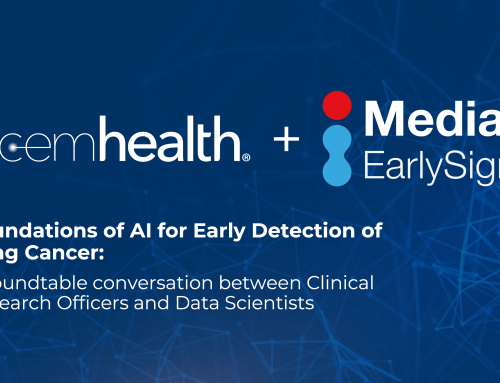
Predictive Analytics in Healthcare: An Overview
Part 1: Introduction to Predictive Analytics in Healthcare
In this first part of our five-section blog post, we’ll delve into the concept and the importance of predictive analytics within the healthcare industry. But what is predictive analytics?
As defined by the University of Southern California (USC) predictive analytics involves the use of statistical techniques and algorithms that can analyze current and historical facts to make predictions about future or unknown events.
Like Machine Learning (ML) and Artificial Intelligence (AI), predictive analytics is becoming somewhat of a buzzword in healthcare. According to a report by Credence Research, the global healthcare predictive analytics market was valued at $1.8 billion in 2019 and is expected to reach $8.46 billion by 2027.
So, why is there such a surge in interest? As healthcare costs continue to soar worldwide, hospitals and health systems are seeking ways to improve care quality and patient outcomes while reducing expenses. Predictive analytics can assist in this, mainly by anticipating the healthcare needs of patients, improving disease management, and optimizing resource allocation.
Take chronic disease management, for example. Using predictive analytics, providers can better identify patients at high risk of developing conditions like diabetes or cardiovascular disease and intervene sooner with preventive care. A case study by Health Catalyst showed how predictive analytics reduced readmission rates for patients with heart failure by 20-30%.
In essence, predictive modeling has the potential to revolutionize patient outcomes and make our healthcare systems more effective and efficient. It’s a promising field that offers plenty of opportunities for implementation and enhancement of healthcare practices in the future.
In upcoming sections, we will delve deeper into the inner workings of predictive analytics, its various use cases in healthcare and the industry-related challenges, and how these obstacles can be overcome.
Part 2: How Predictive Analytics in Healthcare Works
Now we delve deeper into the inner workings of predictive analytics in the healthcare sector. How does this technology transform raw data into valuable predictions?
At the core of predictive analytics lies a collection of statistical techniques and algorithms, including techniques such as regression analysis and machine learning, as described by the National Center for Biotechnology Information (NCBI):
The first step is to collect and organize data. Healthcare data can come from various sources like electronic health records (EHRs), medical imaging, genomic sequencing, wearables and medical devices, and even insurance claims and billing. According to the Office of the National Coordinator for Health Information Technology, patient-generated health data, which includes health history, treatment history, and lifestyle behaviors, can also play a significant role in predictive analytics.
Next, data analysts or machine learning algorithms process and analyze this data to identify patterns and trends. This stage involves data mining, statistical analysis, and predictive modeling. Sometimes, it also involves natural language processing or deep learning, particularly when analyzing unstructured text data or complex image data.
The final step is prediction and deployment. The predictive models generated in the previous step are now used to make predictions about future events. These predictions are then deployed in the real world, assisting clinicians and healthcare organizations in forecasting outcomes and taking proactive actions.
However, it’s crucial to understand that predictive analytics does not replace human decision-making. As the Healthcare Information and Management Systems Society (HIMSS) reminds us, predictive analytics in healthcare serve as a tool that supports clinicians and administrators in making more informed, data-driven decisions.
We’ve now looked at an overview of the process involved in predictive analytics and starting to understand its mechanics. In the next section, we’ll be delving into actual real-world applications and use cases in the healthcare industry.
Part 3: Use Cases of Predictive Analytics in Healthcare
In the third section of our five-part overview about predictive analytics in healthcare, we delve into real-world applications and use cases of this innovative technology.
1. Predicting Patient Readmissions
Hospital readmissions not only inflate healthcare costs but can also indicate a lower quality of care. Predictive analytics can assist in identifying patients at high risk of readmission, helping hospitals apply appropriate preventive measures. According to a study published in the Journal of Hospital Medicine, predictive models can accurately forecast patient readmissions, aiding in targeted care interventions and reductions in healthcare costs.
2. Managing Chronic Conditions
Predictive analytics can also be instrumental in chronic disease management. By analyzing patient data, predictive models can identify patients at higher risk of chronic diseases like diabetes or heart disease. An excellent example of this is Kaiser Permanente’s risk calculation tool used in a study they published for the Journal of the American Medical Association, which identified patients likely to develop hypertension within a year with 73.2% accuracy.
3. Streamlining Hospital Administration
Healthcare providers can also use predictive analytics to anticipate daily patient inflow and streamline operational procedures. A study by the Mayo Clinic developed a model that accurately predicted emergency department volumes, resulting in improved staffing distribution and enhanced patient satisfaction.
4. Early Detection and Intervention in High-Risk Patients
By analyzing patient records, predictive models can highlight patterns that suggest a patient’s potential to develop severe conditions. This application is especially helpful in intensive care units (ICUs), where early intervention can dramatically improve outcomes. An example is the use of predictive analytics by Mount Sinai Hospital to predict the progression of kidney disease. Additionally, early disease detection solutions, such as Reveal, help detect and intervene in the development and management of chronic conditions.
5. Predicting Disease Outbreaks
On a larger scale, predictive analytics can also aid in foreseeing disease outbreaks and pandemics. Google’s now-defunctnow defunct but once historically significant project, Google Flu Trends, attempted to track the influenza virus by analyzing search data. The World Health Organization (WHO) also uses similar methods to predict potential disease outbreaks, as noted in this article by ThoughtWorks.
In our next segment, we will take a look at some of the challenges and limitations faced in implementing predictive analytics in healthcare and discuss what steps the industry needs to take to overcome these barriers.
Part 4: Challenges and Limitations
Predictive analytics holds vast potential within the healthcare industry. However, implementing this technology comes with a set of challenges. In the fourth part of our series, we discuss these limitations, along with potential solutions.
1. Data Quality and Quantity
The success of predictive analytics largely depends on the quality and quantity of the data fed into the model. Data incomplete due to missing records, inaccuracy in manual data entry or inconsistent data coding practices can lead to false or misleading predictions. As outlined by an article in the Journal of Biomedical Informatics, the quality of data hinders the application of predictive analytics in healthcare.
2. Data Integration
Data integration, especially from disparate sources (like EHRs, PACS, RIS, etc.) remains a significant challenge, often due to incompatible system formats and interoperability issues. Such obstacles can prevent a comprehensive view of a patient’s health status, affecting the precision of predictions as per an article by NCBI.
3. Data Privacy and Security
With healthcare data being highly sensitive, data security concerns are often raised in predictive analytics. An article in the Journal of Health & Medical Informatics outlines the potential risks of patient data misuse, emphasizing the need for advanced security measures.
4. Clinical Adoption
Predictive analytics can only be effective if integrated into routine clinical workflows. However, reluctance or inability on the part of healthcare providers to adopt new technologies can restrict its effectiveness, as pointed out by a study in the Journal of Medical Internet Research.
Overcoming the Challenges
Addressing these challenges involves improving data collection, refining data infrastructure, and encouraging interoperability standards. As an example, the Office of the National Coordinator for Health Information Technology (ONC) is working towards seamless health information exchange. Training clinicians to properly use predictive tools and integrating these tools into electronic health record systems can also enhance adoption.
Legislation also plays a part. Robust privacy laws and strong data governance can minimize the risks associated with data security and privacy.
The challenges that predictive analytics face are not insurmountable. By recognizing and proactively addressing these issues, we can unlock the full potential of predictive analytics in healthcare.
Part 5: The Future of Predictive Analytics in Healthcare
In the final part of our overview, we’ll explore what lies ahead for predictive analytics in the healthcare sector.
1. Personalized Treatment
In the future, predictive analytics may play a pivotal role in developing personalized treatments and precision medicine. By analyzing an individual’s health records, genomic data, and lifestyle information, predictive models can enable healthcare professionals to design treatment plans tailored to the patient’s specific needs. As per an article in Nature Medicine, personalized medicine is a growing trend in healthcare and predictive analytics will accelerate this movement.
2. Telemedicine and Remote Patient Monitoring
The rise of telemedicine and remote patient monitoring offers even more possibilities for predictive analytics. Smart devices, wearables, and health apps generate valuable health data that predictive models can use to make real-time health assessments. A study by RAND Corporation suggests that this will help in immediate recognition of health issues and timely interventions in the future.
3. Population Health Management
Predictive analytics can also support population health management by identifying health trends and risk factors within specific patient populations. This can guide public health initiatives and policies, contributing to improved population health outcomes. This was illustrated in a review in the Journal of Infection and Public Health.
4. AI and Machine Learning
Artificial Intelligence (AI) and Machine Learning (ML) are expected to considerably aid the growth of predictive analytics in healthcare. They can help analyze vast and diverse data sets, uncover insights regarding health risks and conditions, and predict future patient outcomes more accurately. According to an article in Health IT Analytics, AI and ML will be central to the future development of predictive analytics in healthcare. In fact, many companies, such as us at Lucem Health, are pioneering this forward, all while making solutions integrated both from a data and clinical workflow perspective.
5. Real-Time Alerts
With the advancement of predictive analytics, healthcare systems may soon provide real-time alerts for patients’ critical health parameters, improving health monitoring and enabling quick responses to emergency situations. The potential of this application is discussed in research by Springer Nature.
Predictive analytics in healthcare is a burgeoning field with immense untapped potential. As technology advances, so will its impact on patient care, healthcare management, and overall industry progress. While there are challenges to overcome, the future of predictive analytics shines brightly on the horizon. If you’ve got questions about predictive analytics, or how we’re leveraging it at Lucem Health – let us know!
